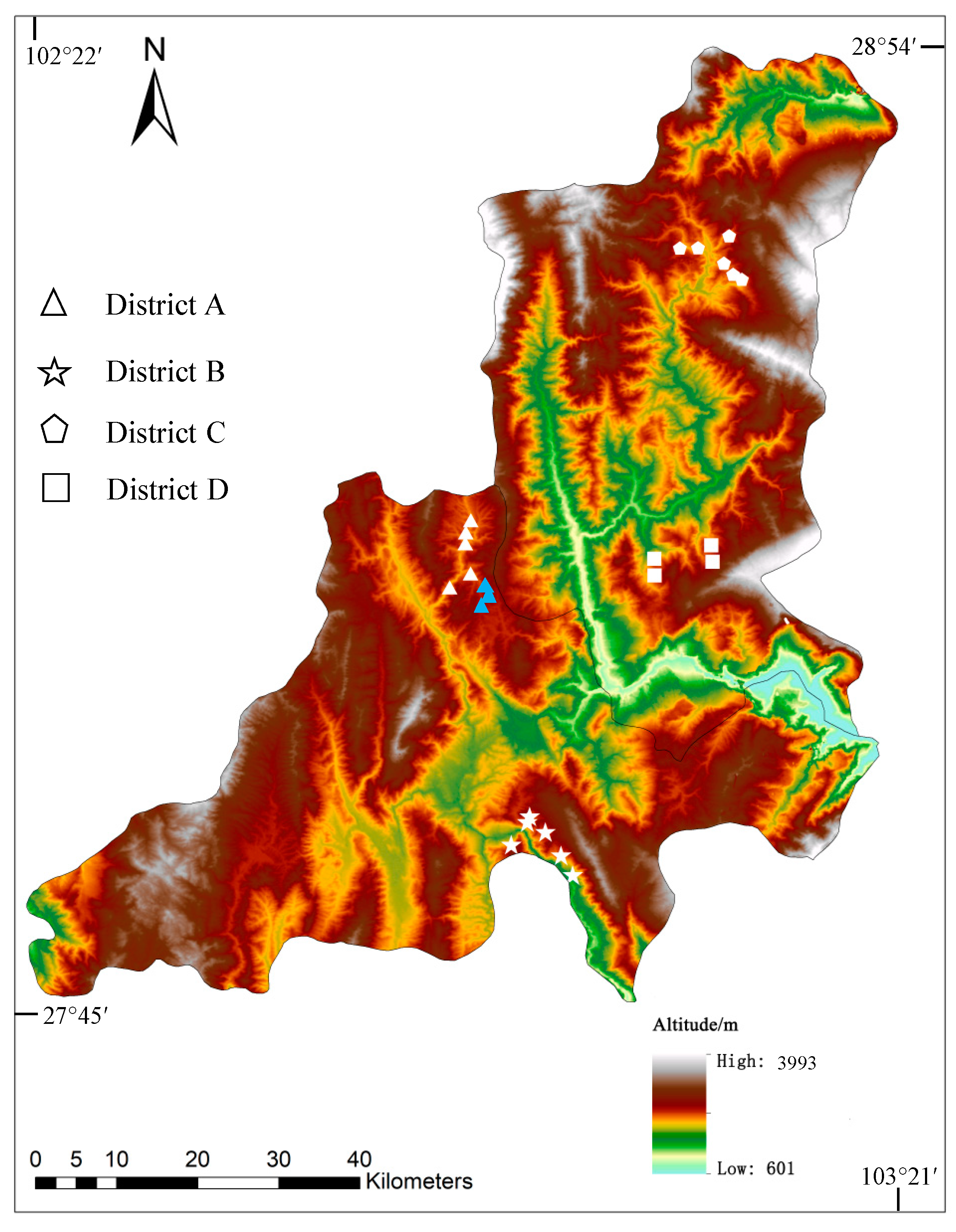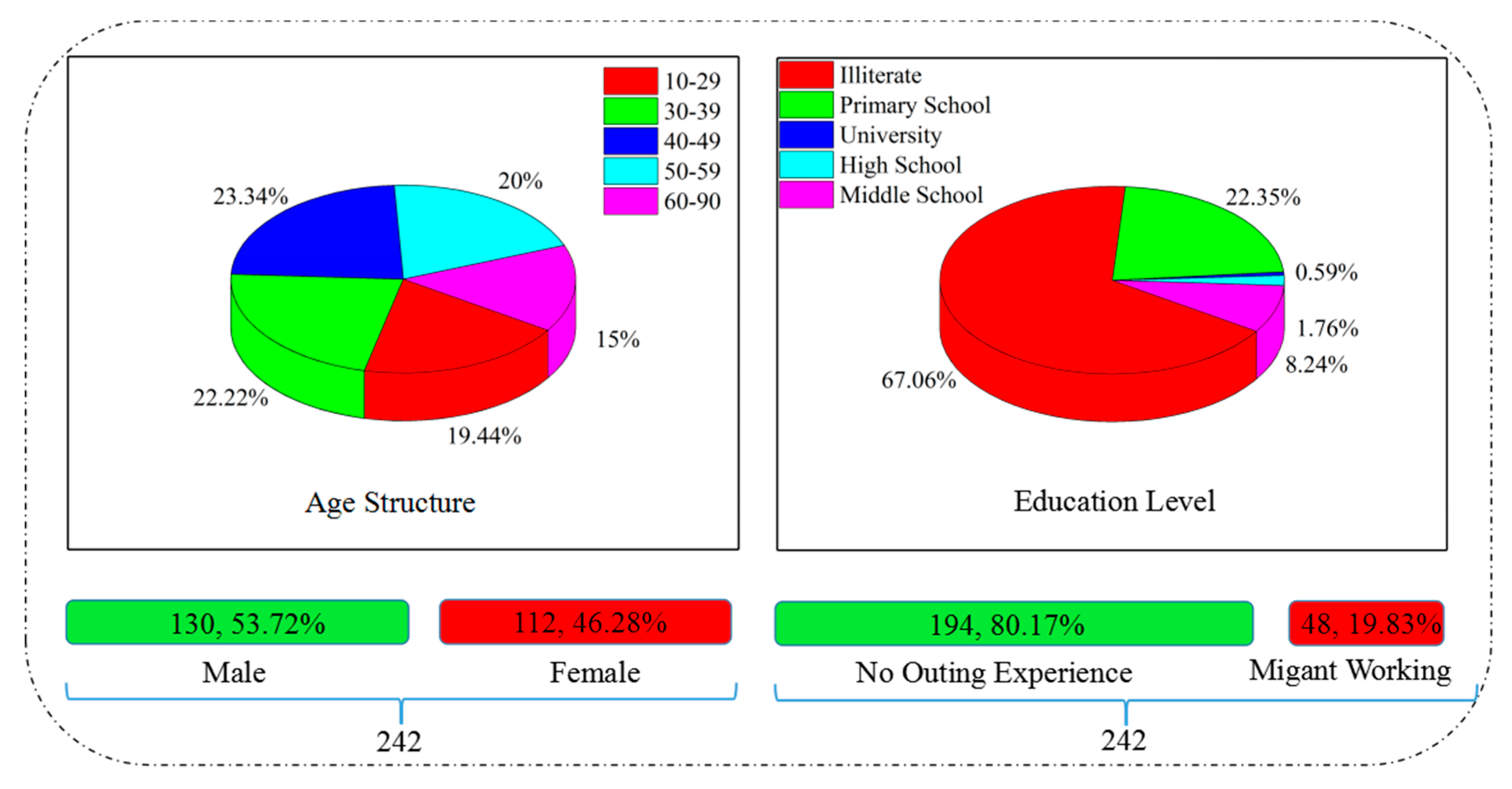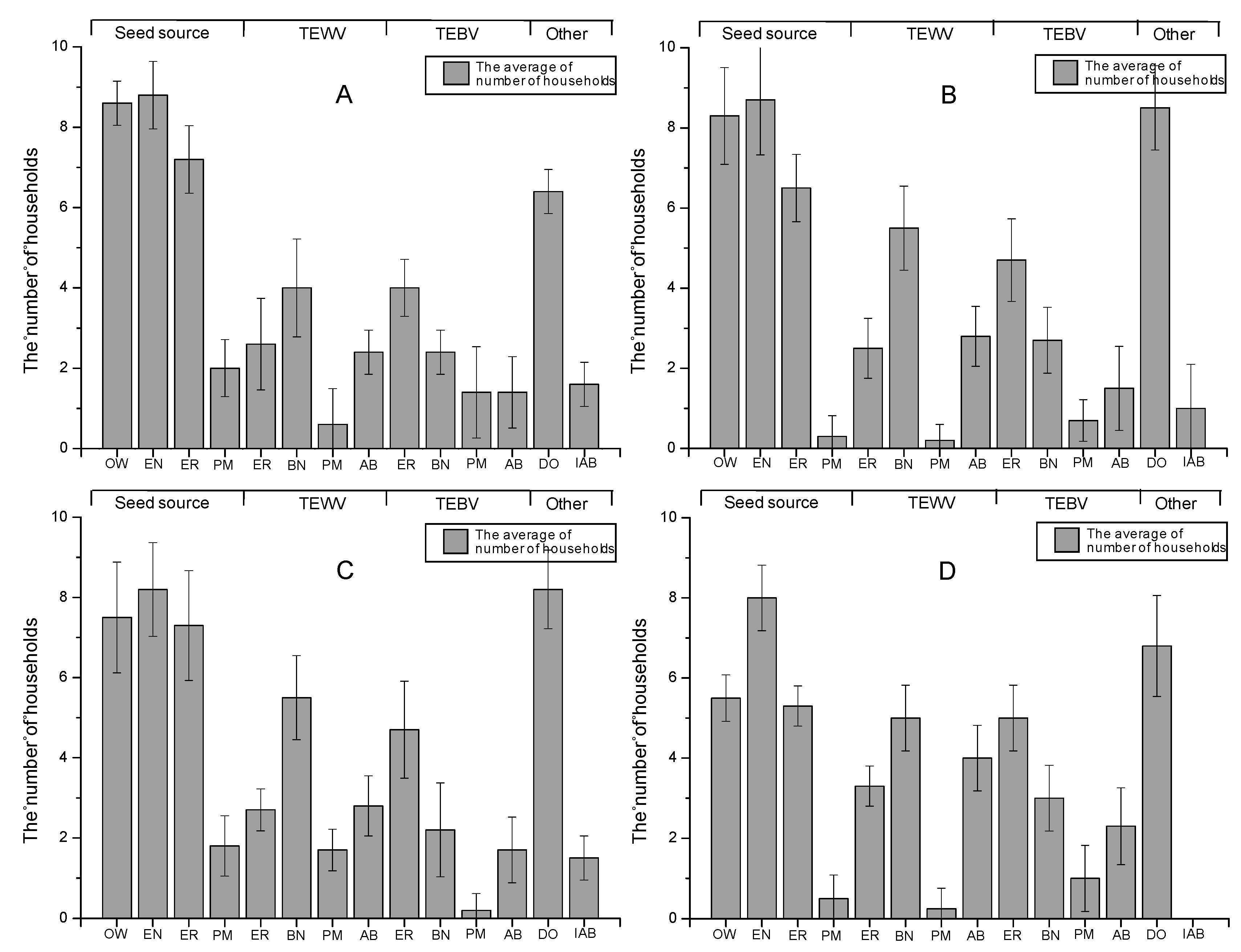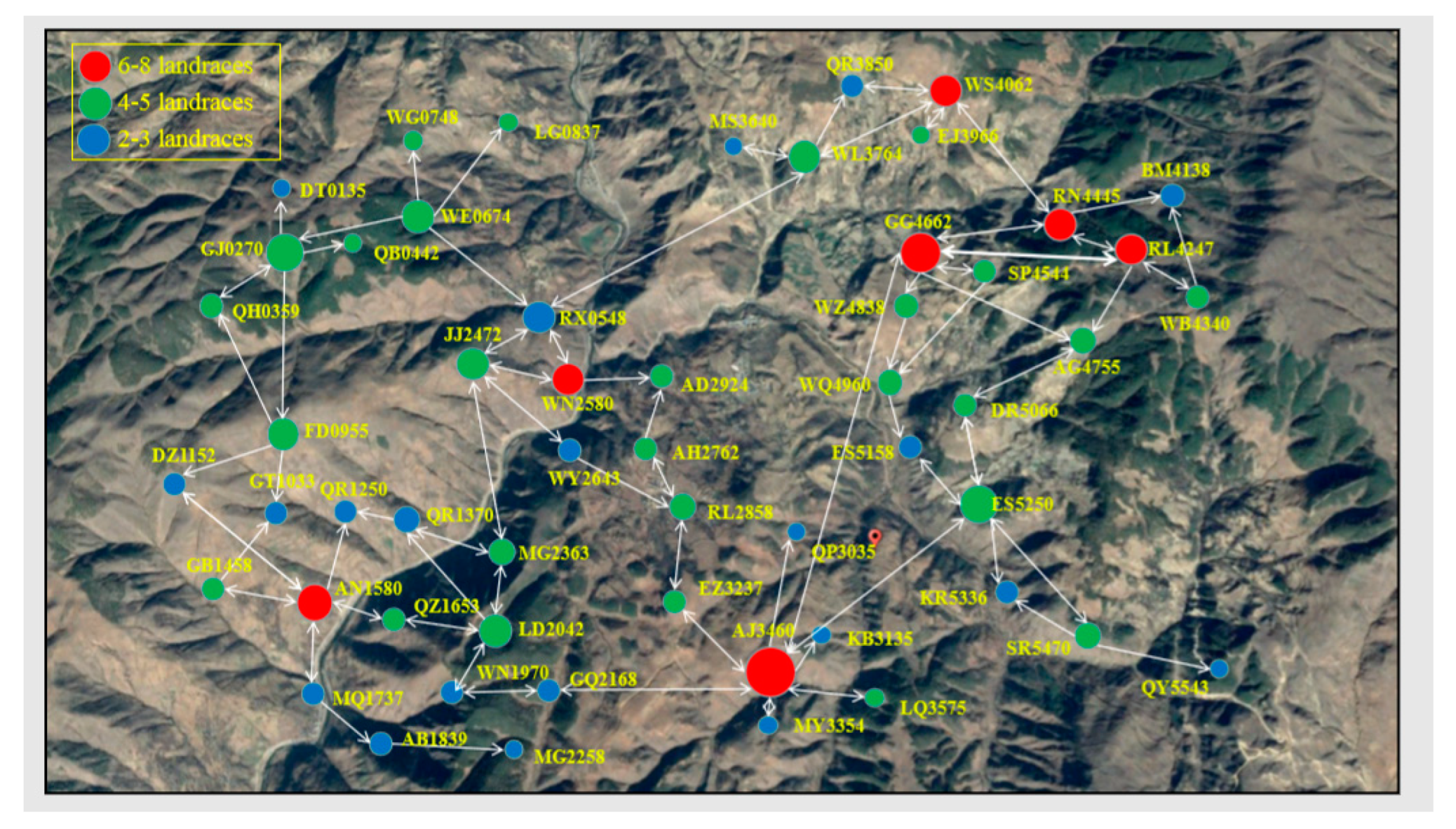Network Analysis of Seed Flow, a Traditional Method for Conserving Tartary Buckwheat (Fagopyrum tataricum) Landraces in Liangshan, Southwest China
Abstract
1. Introduction
2. Materials and Methods
2.1. Study Sites
2.2. Household Seed System Survey
2.3. Data Analysis
3. Results
3.1. Seed Sources
3.2. Flows and Sources of Tartary Buckwheat Landraces
3.3. Analysis of Centrality Data
3.4. Analysis of Network Map
4. Discussion
4.1. Structure of Seed Exchange Network and Flows of Landraces
4.2. Centrality Analysis and Tartary Buckwheat Landraces Conservation
4.3. Factors Affecting the Structure of Seed Exchange Networks
5. Conclusions
Supplementary Materials
Author Contributions
Funding
Acknowledgments
Conflicts of Interest
References
- Coomes, O.T.; McGuire, S.J.; Garine, E.; Caillon, S.; McKey, D.; Demeulenaere, E.; Jarvis, D.; Aistara, G.; Barnaud, A.; Clouvel, P.; et al. Farmer seed networks make a limited contribution to agriculture? Four common misconceptions. Food Policy 2015, 56, 41–50. [Google Scholar] [CrossRef]
- Biemond, P.C.; Oguntade, O.; Lava-Kumr, P.; Stomph, T.J.; Termorshuizen, A.J.; Struik, P.C. Does the informal seed system threaten cowpea seed health? Crop Prot. 2013, 43, 66–174. [Google Scholar] [CrossRef]
- Louwaars, N.P.; De Boef, S. Integrated seed sector development in Africa: A conceptual framework for creating coherence between practices, programs, and policies. J. Crop Improv. 2012, 26, 39–59. [Google Scholar] [CrossRef]
- Van-Gastel, T.J.G.; Gregg, B.R.; Asiedu, E.A. Seed quality control in developing counties. J. New Seeds 2002, 4, 117–130. [Google Scholar] [CrossRef]
- Bellon, R.M. Conceptualizing interventions to support on-farm genetic resource conservation. World Dev. 2004, 32, 159–172. [Google Scholar] [CrossRef]
- Brush, S.B. Farmers’ Bounty. Locating Crop Diversity in the Contemporary World; Yale University Press: New Haven, CT, USA, 2004. [Google Scholar]
- Lu, B.R. Diversity of rice genetic resources and its utilization and conservation. Chin. Biodivers. 1998, 6, 63–72. (In Chinese) [Google Scholar]
- Bellon, M.R. Do we need crop landraces for the future? Realizing the global option value of in situ conservation. In Agrobiodiversity Conservation and Economic Development; Kontoleon, A., Pascual, U., Smale, M., Eds.; Routledge: London, UK, 2009; pp. 51–59. [Google Scholar]
- Bellon, M.R.; Gotor, E.; Caracciolo, F. Conserving landraces and improving livelihoods: How to assess the success of on-farm conservation projects? Int. J. Agric. Sustain. 2014, 12, 167–182. [Google Scholar] [CrossRef]
- Engles, J.M.M.; Dempewolf, H.; Henson-Apollonio, V. Ethical consideration in agro-biodiversity research, collecting, and use. J. Agric. Environ. Ethics 2011, 24, 107–126. [Google Scholar] [CrossRef]
- Coomes, O.T. Of stakes, stems, and cuttings: The importance of local seed systems in traditional Amazonian societies. Prof. Geogr. 2010, 62, 323–334. [Google Scholar] [CrossRef]
- Leclerc, C.; d’Eeckenbrugge, G.C. Social organization of crop genetic diversity. The G × E × S interaction model. Diversity 2012, 4, 1–32. [Google Scholar] [CrossRef]
- Jarvis, D.; Hodgkin, T.; Brown, A.H.; Tuxill, J.; Noriega, I.L.; Smale, M.; Sthapit, B. Crop Genetic Diversity in the Field and on the Farm: Principles and Applications in Research Practices; Yale University Press: New Haven, CT, USA, 2016. [Google Scholar]
- Zuo, X.N.; Ehmke, R.; Mennes, M.; Imperati, D.; Castellanos, F.X.; Sporns, O.; Michael, P.M. Network centrality in the human functional connectome. Cereb. Cortex 2011, 22, 1862–1875. [Google Scholar] [CrossRef]
- Delaunay, S.; Tescar, R.P.; Oualbego, A.; vom Brocke, K.; Lancon, J. Growing cotton does not disrupt traditional sorghum seed exchange. Cah. Agric. 2008, 17, 189–194. [Google Scholar]
- Sirbanchongkran, A. Varietal turnover and seed exchange: Implications for conservation of rice genetic diversity on farm. Int. Rice Res. Notes 2004, 29, 12–14. [Google Scholar]
- Emperaire, L.; Peroni, N. Traditional management of agrobiodiversity in Brazil: A case study of manioc. Hum. Ecol. 2007, 35, 761–768. [Google Scholar] [CrossRef]
- Delêtr, M.B.; Mckey, D.R.; Hodkinson, T. Marriage exchanges, seed exchanges, and the dynamics of manioc diversity. Proc. Natl. Acad. Sci. USA 2011, 108, 18249–18254. [Google Scholar] [CrossRef]
- Perales, H.R.; Benz, B.F.; Brush, S.B. Maize diversity and ethnolinguistic diversity in Chiapas, Mexico. Proc. Natl. Acad. Sci. USA 2005, 102, 949–954. [Google Scholar] [CrossRef]
- Berthouly, C. How does farmer connectivity influence livestock genetic structure? A case-study in a Vietnamese goat population. Mol. Ecol. 2009, 18, 3980–3991. [Google Scholar] [CrossRef]
- Jarvis, D.I.; Hodgkin, T.; Sthapit, B.R.; Fadda, C.; Lopez-Noriega, I. An heuristic framework for identifying multiple ways of supporting the conservation and use of traditional crop varieties within the agriculture production system. Crit. Rev. Plant Sci. 2011, 30, 25–176. [Google Scholar] [CrossRef]
- Mbabwine, Y.; Sabiiti, E.N.; Kiambin, D.; Mulumba, J.W. Ecogeographic genetic erosion, seed system and conservation of plant genetic resources in Kabale highlands, Uganda. Plant Genet. Resour. Newsl. 2008, 156, 33–41. [Google Scholar]
- Carpenter, D. The in situ conservation of rice plant genetic diversity: A case study from a Philippine Barangay. Agric. Hum. Values 2005, 22, 421–434. [Google Scholar] [CrossRef]
- Sperling, L.; McGuire, S.J. Persistent myths about emergency seed aid. Food Policy 2010, 35, 195–201. [Google Scholar] [CrossRef]
- Helicke, N.A. Seed exchange networks and food system resilience in the United States. J. Environ. Stud. Sci. 2015, 5, 636–649. [Google Scholar] [CrossRef]
- McGuire, S.J.; Sperling, L. Seed systems smallholder farmers use. Food Secur. 2016, 8, 179–195. [Google Scholar] [CrossRef]
- Myers, N.; Mittermeier, R.A.; Mittermeier, C.G.; da Fonseca, G.A.B.; Kent, J. Biodiversity hotspots for conservation priorities. Nature 2000, 403, 853–858. [Google Scholar] [CrossRef]
- Xu, F.R.; Tang, C.F.; Yu, T.Q.; Dai, L.Y.; Zhang, H.S. Diversity of paddy rice varieties from Yuanyang Hani’s terraced fields in Yunnan, China. Acta Ecol. Sin. 2010, 30, 3346–3357. [Google Scholar]
- Xu, F.R.; Yang, Y.Y.; Zhang, E.L.; A, X.X.; Tang, C.F.; Dong, C.; Zhang, F.F.; Liu, X.; Dai, L.Y. On-farm conservation and utilization of paddy rice, wheat and maize landrace varieties in 15 unique ethnic groups in Yunnan, China. Hereditas 2012, 34, 1465–1474. [Google Scholar] [CrossRef]
- Jones, M.K.; Liu, X.Y. Origins of agriculture in East Asia. Science 2009, 324, 730–731. [Google Scholar] [CrossRef]
- Bisht, I.S.; Mehta, P.S.; Bhandari, D.C. Traditional crop diversity and its conservation on-farm for sustainable agricultural production in Kumaon Himalaya of Uttaranchal state: A case study. Genet. Resour. Crop Evol. 2007, 54, 345–357. [Google Scholar] [CrossRef]
- Ohnishi, O. Discovery of new Fagopyrum species and its implication for the studies of evolution of Fagopyrum and of the origin of cultivated buckwheat. In Current Advances in Buckwheat Research; Matano, T., Ujihara, A., Eds.; Shinshu University Press: Nagano, Japan, 2016; Volume I–III, pp. 175–190. [Google Scholar]
- Alexiades, M.N.; Sheldon, J.W. Selected Guidelines for Ethnobotanical Research: A Field Manual; New York Botanical Garden: New York, NY, USA, 1991. [Google Scholar]
- Long, C.; Wang, J. The Principle, Method and Application of Participatory Rural Assessment; Yunnan Science and Technology Press: Kunming, China, 1996. [Google Scholar]
- Chambers, R. The origins and practice of participatory rural appraisal. World Dev. 1994, 22, 953–969. [Google Scholar] [CrossRef]
- Chambers, R. Participatory rural appraisal (PRA): Challenges, potentials and paradigm. World Dev. 1994, 22, 1437–1454. [Google Scholar] [CrossRef]
- Borgatti, S.; Everett, M.; Freeman, L. NciNet Visualization; Analytic Technologies: Lexington, KY, USA, 2012. [Google Scholar]
- Abay, F.; de Boef, W.; Bjørnstad, A. Network analysis of barley seed flows in Tigray, Ethiopia: Supporting the design of strategies that contribute to on-farm management of plant genetic resources. Plant Genet. Resour. 2011, 9, 495–505. [Google Scholar] [CrossRef]
- Badstue, L.B.; Bellon, M.R.; Berthaud, J.; Ramírez, A.; Flores, D.; Juárez, X. The dynamics of gardeners’ maize seed supply practices in the Central Valleys of Oaxaca, Mexico. World Dev. 2007, 35, 1579–1593. [Google Scholar] [CrossRef]
- Stromberg, P.; Pascual, U.; Bellon, M.R. Seed system and farmers’ seed choices: The case of maize in the Peruvian Amazon. Hum. Ecol. 2010, 38, 539–553. [Google Scholar] [CrossRef]
- Calvet-Mir, L.; Calvet-Mir, M.; Vaqué-Nuñez, L.; Reyes-García, V. Landraces in situ conservation: A case study in high-mountain home gardens in Vall Fosca, Catalan Pyrenees, Iberian Peninsula. Econ. Bot. 2011, 65, 146–157. [Google Scholar] [CrossRef]
- Alvarez, N.; Garine, E.; Khasah, C.; Dounias, E.; Hossaert-McKey, M.; Mckey, D. Farmers’ practices, metapopulation dynamics, and conservation of agricultural biodiversity on-farm: A case study of sorghum among the Duupa in sub-sahelian Cameroon. Biol. Conserv. 2005, 121, 533–543. [Google Scholar] [CrossRef]
- Vigouroux, Y.; Barnaud, A.; Scarcelli, N.; Thuillet, A.C. Biodiversity, evolution and adaptation of cultivated crops. Comptes Rendus Biol. 2011, 334, 450–457. [Google Scholar] [CrossRef]
- Zeven, A.C. The traditional inexplicable replacement of seed and seed ware of landraces and cultivars: A review. Euphytica 1999, 110, 181–191. [Google Scholar] [CrossRef]
- Van Niekerk, J.; Wynberg, R. Traditional seed and exchange systems cement social relations and provide a safety net: A case study from KwaZulu-Natal, South Africa. Agroecol. Sustain. Food Syst. 2017, 41, 1099–1123. [Google Scholar] [CrossRef]
- Thiele, G. Informal potato seed systems in the Andes: Why are they important and what should we do with them? World Dev. 1999, 27, 83–99. [Google Scholar] [CrossRef]
- Badstue, L.B.; Bellon, M.R.; Berthaud, J.; Juarez, X.; Rosas, I.M.; Solano, A.M.; Ramirez, A. Examining the role of collective action in an informal seed system: A case study from the central valleys of Oaxaca, Mexico. Hum. Ecol. 2006, 34, 249–273. [Google Scholar] [CrossRef]
- Dyer, G.A.; González, C.; Lopera, D.C. Informal “seed” systems and the management of gene flow in traditional agroecosystems: The case of cassava in Cauca, Colombia. PLoS ONE 2011, 6, e29067. [Google Scholar] [CrossRef]
- Subedi, A.; Chaudhary, P.; Baniya, B.; Rana, R.; Tiwari, R.; Rijal, D.; Sthapit, B.; Jarvis, D. Who maintains crop genetic diversity and how: Implication for on farm conservation and utilization? Cult. Agric. 2003, 25, 14–50. [Google Scholar] [CrossRef]




| District | NO. | Sample Site | Longitude | Latitude | Altitude (m) | Households Interviewed |
|---|---|---|---|---|---|---|
| A | 1 | Gemowaxi | 102.84 | 28.22 | 2280 | 9 |
| 2 | Kumo | 102.86 | 28.27 | 2370 | 9 | |
| 3 | Hajue | 102.87 | 28.28 | 2380 | 10 | |
| 4 | Juega | 102.86 | 28.30 | 2400 | 8 | |
| 5 | Wazhajiagu | 102.86 | 28.24 | 2390 | 10 | |
| B | 6 | Hexi | 102.91 | 27.94 | 2360 | 8 |
| 7 | Tangqie | 102.97 | 27.90 | 2050 | 9 | |
| 8 | Tubizili | 102.96 | 27.93 | 2460 | 11 | |
| 9 | Luogu | 102.94 | 27.95 | 2530 | 8 | |
| 10 | Aweiluoha | 102.93 | 27.97 | 2520 | 9 | |
| 11 | Taodu | 102.92 | 27.96 | 2360 | 9 | |
| C | 12 | Ejue | 103.15 | 28.57 | 2540 | 10 |
| 13 | Ejueerzu | 103.16 | 28.57 | 2540 | 8 | |
| 14 | Ema | 103.14 | 28.58 | 2430 | 10 | |
| 15 | Yideamo | 103.15 | 28.61 | 2440 | 9 | |
| 16 | Gandu | 103.11 | 28.60 | 2270 | 7 | |
| 17 | Cainaijian | 103.09 | 28.60 | 2250 | 9 | |
| D | 18 | Yise | 103.13 | 28.27 | 2470 | 7 |
| 19 | Wanigu | 103.13 | 28.25 | 2520 | 9 | |
| 20 | Yideamo | 103.07 | 28.27 | 2470 | 8 | |
| 21 | Yiluoerhe | 103.07 | 28.25 | 2080 | 10 | |
| Case study | 22 | Juetuo | 102.86 | 28.20 | 2400 | 22 |
| 23 | Anqule | 102.86 | 28.20 | 2200 | 13 | |
| 24 | Wazachongle | 102.86 | 28.21 | 2390 | 20 |
| Tartary Buckwheat Landraces as Seed Source by Household Number | ||||||||
|---|---|---|---|---|---|---|---|---|
| No. | Landraces | Local Name | Within Village | Outside Village | Dowry | Agriculture Bureau | ||
| Neighbors | Relatives | Relatives | Market | |||||
| 1 | en g tumuer | nɡɯ33 tɕu33 | 86 | 67 | 93 | 11 | 56 | 0 |
| 2 | en g wu | nɡɯ33 vu33 | 77 | 53 | 58 | 6 | 41 | 0 |
| 3 | shuang lang g | ʒuo33 ɬɯ21 | 79 | 51 | 62 | 7 | 26 | 0 |
| 4 | ri g | tshu33 nɡɯ33 | 39 | 21 | 46 | 0 | 17 | 0 |
| 5 | en g nao | nɡɯ33 nuo33 | 11 | 6 | 15 | 5 | 0 | 3 |
| 6 | hai ga g | hie33 ɬɯ21 nɡɯ33 | 19 | 6 | 15 | 3 | 0 | 20 |
| 7 | wo g | wo33 nɡɯ33 | 9 | 5 | 11 | 0 | 0 | 0 |
| 8 | en g jie | nɡɯ33 tɕᴇ33 | 12 | 3 | 15 | 0 | 3 | 0 |
| 9 | en g chi | nɡɯ33 tɕhɿ21 | 5 | 1 | 4 | 0 | 1 | 0 |
| 10 | en g zhi | nɡɯ33 ɪᴀ33 | 0 | 0 | 2 | 0 | 0 | 0 |
| 11 | en g la | nɡɯ33 pu33 | 0 | 0 | 3 | 0 | 0 | 2 |
| 12 | en g bu | nɡɯ33 tshu33 | 1 | 0 | 1 | 0 | 0 | 1 |
| 13 | en g chu | nɡɯ33 tʂhi33 | 0 | 0 | 2 | 0 | 0 | 0 |
| Village | Household | Nodal Data Calculated on the Basis of Network Analysis | Position in Network | ||
|---|---|---|---|---|---|
| Degree | Closeness | Betweenness | |||
| 22 | DT0135 | 1.69 | 9.75 | 0.00 | - |
| GJ0270 | 8.47 | 10.68 | 14.82 | NC | |
| QH0359 | 3.39 | 9.98 | 0.00 | C | |
| QB0442 | 1.69 | 9.75 | 0.00 | - | |
| WE0674 | 6.78 | 11.23 | 19.38 | NC | |
| WG0748 | 1.69 | 10.20 | 0.00 | - | |
| LG0837 | 1.69 | 10.20 | 0.00 | - | |
| FD0955 | 6.78 | 10.29 | 7.85 | NC | |
| GT1033 | 3.39 | 9.76 | 1.06 | C | |
| DZ1152 | 3.39 | 10.12 | 4.51 | C | |
| QR1250 | 3.39 | 10.48 | 3.40 | C | |
| QR1370 | 5.08 | 11.02 | 5.04 | NC | |
| GB1458 | 3.39 | 9.70 | 1.12 | - | |
| AN1580 | 8.47 | 10.33 | 15.15 | NC | |
| QZ1653 | 3.39 | 10.74 | 9.99 | C | |
| MQ1737 | 3.39 | 9.51 | 6.07 | C | |
| AB1839 | 3.39 | 8.79 | 3.09 | C | |
| WN1970 | 3.39 | 10.86 | 10.19 | C | |
| LD2042 | 6.78 | 11.32 | 15.60 | NC | |
| GQ2168 | 3.39 | 10.70 | 9.68 | C | |
| MG2258 | 1.69 | 8.14 | 0.00 | - | |
| 23 | RX0548 | 6.78 | 11.80 | 25.18 | NC |
| MG2363 | 5.08 | 11.45 | 12.61 | NC | |
| JJ2472 | 6.78 | 11.89 | 20.27 | NC | |
| WN2580 | 6.78 | 11.82 | 20.51 | NC | |
| WY2643 | 3.39 | 11.28 | 6.62 | C | |
| AH2762 | 3.39 | 10.53 | 1.03 | C | |
| RL2858 | 5.08 | 10.84 | 7.09 | NC | |
| AD2924 | 3.39 | 11.02 | 2.30 | C | |
| QP3035 | 1.69 | 9.94 | 0.00 | - | |
| KB3135 | 1.69 | 9.94 | 0.00 | - | |
| EZ3237 | 3.39 | 10.63 | 6.18 | C | |
| MY3354 | 1.69 | 9.94 | 0.00 | - | |
| AJ3460 | 11.86 | 10.92 | 20.82 | NC | |
| LQ3575 | 1.69 | 9.94 | 0.00 | - | |
| 24 | MS3640 | 1.69 | 9.96 | 0.00 | - |
| WL3764 | 6.78 | 10.94 | 8.87 | NC | |
| QR3850 | 3.39 | 10.26 | 0.00 | - | |
| EJ3966 | 1.69 | 9.72 | 0.00 | - | |
| WS4062 | 6.780 | 10.65 | 6.06 | NC | |
| BM4138 | 3.390 | 9.86 | 0.17 | C | |
| RL4247 | 6.780 | 10.94 | 4.90 | NC | |
| WB4340 | 3.390 | 10.00 | 0.27 | C | |
| RN4445 | 6.780 | 10.78 | 7.07 | NC | |
| SP4544 | 3.390 | 10.80 | 1.69 | C | |
| GG4662 | 10.16 | 11.61 | 20.95 | NC | |
| AG4755 | 5.08 | 11.06 | 9.46 | NC | |
| WA4838 | 3.39 | 10.80 | 1.69 | C | |
| WQ4960 | 5.08 | 10.36 | 2.81 | C | |
| DR5066 | 3.39 | 10.72 | 8.57 | C | |
| ES5158 | 3.39 | 10.27 | 2.25 | NC | |
| ES5250 | 8.47 | 10.78 | 16.45 | NC | |
| KR5336 | 3.39 | 9.86 | 0.00 | - | |
| SR5470 | 5.08 | 9.88 | 3.08 | NC | |
| QY5543 | 1.69 | 9.07 | 0.00 | - | |
© 2019 by the authors. Licensee MDPI, Basel, Switzerland. This article is an open access article distributed under the terms and conditions of the Creative Commons Attribution (CC BY) license (http://creativecommons.org/licenses/by/4.0/).
Share and Cite
Song, Y.; Fang, Q.; Jarvis, D.; Bai, K.; Liu, D.; Feng, J.; Long, C. Network Analysis of Seed Flow, a Traditional Method for Conserving Tartary Buckwheat (Fagopyrum tataricum) Landraces in Liangshan, Southwest China. Sustainability 2019, 11, 4263. https://doi.org/10.3390/su11164263
Song Y, Fang Q, Jarvis D, Bai K, Liu D, Feng J, Long C. Network Analysis of Seed Flow, a Traditional Method for Conserving Tartary Buckwheat (Fagopyrum tataricum) Landraces in Liangshan, Southwest China. Sustainability. 2019; 11(16):4263. https://doi.org/10.3390/su11164263
Chicago/Turabian StyleSong, Yingjie, Qiong Fang, Devra Jarvis, Keyu Bai, Dongmei Liu, Jinchao Feng, and Chunlin Long. 2019. "Network Analysis of Seed Flow, a Traditional Method for Conserving Tartary Buckwheat (Fagopyrum tataricum) Landraces in Liangshan, Southwest China" Sustainability 11, no. 16: 4263. https://doi.org/10.3390/su11164263
APA StyleSong, Y., Fang, Q., Jarvis, D., Bai, K., Liu, D., Feng, J., & Long, C. (2019). Network Analysis of Seed Flow, a Traditional Method for Conserving Tartary Buckwheat (Fagopyrum tataricum) Landraces in Liangshan, Southwest China. Sustainability, 11(16), 4263. https://doi.org/10.3390/su11164263






